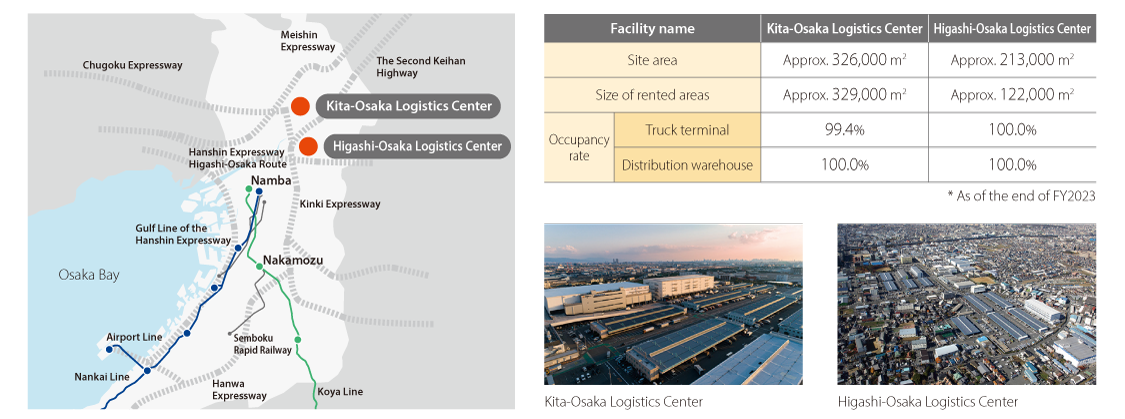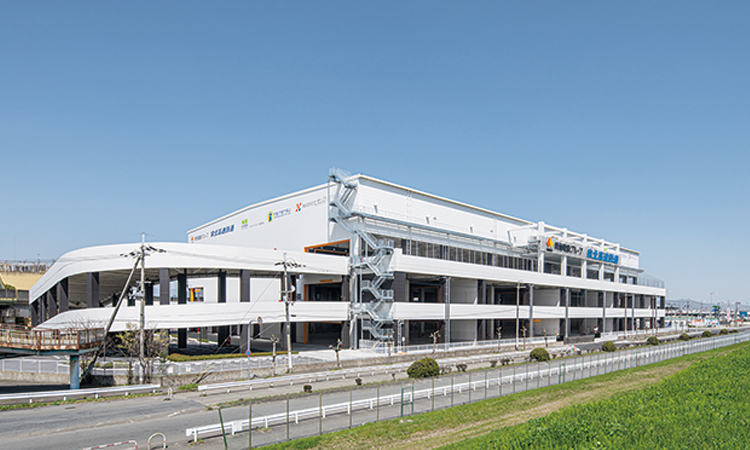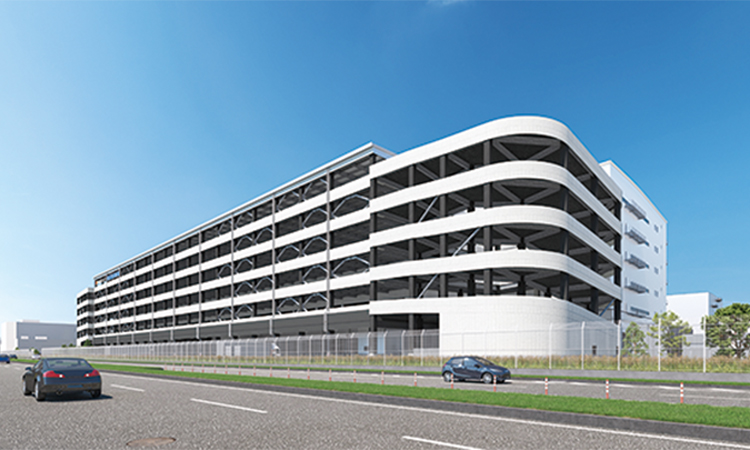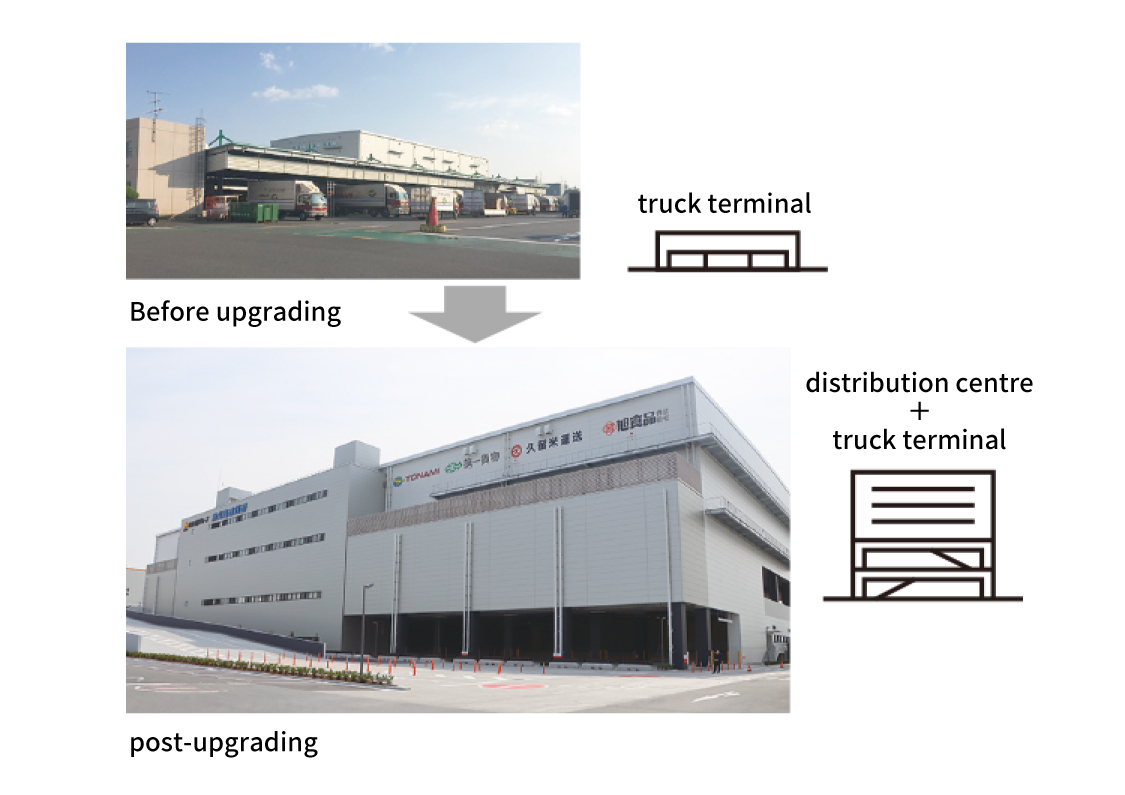Enhancing the functions of distribution sites
that underpin social infrastructure
Basic concepts
The logistics business is expected to play a role in supporting sustainable economic growth and safe, secure, and prosperous lifestyles even under the recent population decline. To meet the increasing demand for logistics services year after year, the Group is committed to supporting the logistics industry by providing trucking infrastructure services.
Truck terminal overview
Distribution centers are major distribution hubs that have been built in key transportation hubs on the periphery of cities to fundamentally resolve the decline in distribution and urban functions caused by the dramatic increase in automobile traffic, and to relieve the excessive concentration of population and industry in urban centers during the period of rapid economic growth.
The Group’s distribution centers include distribution warehouses, delivery centers, and other facilities located together on a vast site centered on truck terminals in Higashi Osaka (approximately 175,000 m2, in eastern Osaka) and Kita Osaka (195,000 m2, in northern Osaka).

The distribution centers are located near the center of Osaka City and expressway interchanges, enabling efficient transportation, and their inland locations eliminate the risk of tsunami. Furthermore, the sites are located within distribution business districts and can be operated 24 hours a day, 365 days a year, which is a great advantage for logistics business sites.
The truck terminals are facilities where goods brought in by large trucks from all over Japan are reloaded onto smaller trucks by destination and transported to surrounding cities, while goods collected from surrounding cities are reloaded onto large trucks and transported nationwide. As the public truck terminals are used by many freight forwarders, they play an important role in supporting people’s daily lives and industrial activities.
In response to the recent large-scale natural disasters, both terminals have been designated by the Ministry of Land,
Infrastructure, Transport and Tourism as civilian supply centers in times of disaster due to their prime locations, and their roles are increasing.

Truck terminal strengths
Utilizing the functions of the public truck terminal it has operated for some time, the Group is constructing a logistics complex that will combine the functions of a truck terminal and a delivery center. By having a truck terminal take over the transportation of cargo at the delivery center, pickup and waiting times can be greatly reduced.
After upgrading, the large logistics facility will enable efficient business operations through the consolidation of scattered locations and the ability to install large-scale conveying equipment. In addition, the facility will provide logistics operators with a variety of benefits to address the 2024 logistics problem, including reduced labor hours through reduced time spent picking up and waiting for cargo. This will be achieved through ample truck parking provided adjacent to the facility, and a comfortable working environment through the provision of amenity halls, shower rooms, and sleeping rooms in the facility.
Also, each facility completed in recent years has acquired the DBJ Green Building certification, which has environmental.
Future prospects for the truck terminals
At the Kita Osaka Distribution Center, we are promoting the Phase II building project for the Kita Osaka Truck Terminal, one of the largest in the Kansai region, and construction work began in June 2024 with the aim of completing the building in March 2026. Two more advanced facilities have also been planned and are being rebuilt into more up-to-date facilities.
Meanwhile, the Higashi-Osaka Logistics Center is also in the planning stages to replace the old facility with a new, more sophisticated one.
In preparation for natural disasters, which have become more frequent in recent years, we are actively working to adopt seismically isolated structures, install emergency power generation equipment, and install solar power generation on the rooftop.
In the future, we will continue to create facilities that meet the needs of the logistics industry and society as a whole, including the installation of charging space for EV trucks, which are becoming increasingly popular, and support for semi-trailer trucks.
Osaka Prefectural Food Products Distribution Center, Building E
At the Kita Osaka Truck Terminal Redevelopment Project, we completed Osaka Prefectural Food Products Distribution Center, Building E in March 2023. For the Osaka Prefectural Food Products Distribution Center, we completed the construction of Building A after its upgrade and vertical expansion two years ago. Building E was then constructed on the land freed up by this work. The facility, with a total floor area of approximately 50,000 m2 (four-story warehouse section), is expected to help increase the revenue at the Kita Osaka Truck Terminal.

Kita Osaka Truck Terminal Phase II Building
Following Osaka Prefectural Food Products Distribution Center, Building E, we have decided to begin planning for the development of the Kita Osaka Truck Terminal Phase II Building. The project will be completed in March 2026 at a total cost of approximately 35 billion yen, and will consist of a six-story truck terminal and distribution center with a total floor area of approximately 180,000 m2 .The project is expected to be completed in March 2026 at a total cost of approximately 35 billion yen. By adopting a seismic isolation structure and improving the BCP, we will make sure that the building will accommodate needs of a wide range of tenants.

Overall timeline for upgrading the logistics facilities

Image of truck terminal development

Sustainability Site Map
(materiality)
- Major sustainability themes (materiality)
- Identification processes
- Further seek safety, security, and satisfaction
- Thriving and friendly community development
- Create a future full of dreams
- Achieve an enriched life
- Develop a workplace and staff in a way that enables each person to put their abilities to use
-
Contribute to preserving the global environment
- Environmental philosophy
- Reducing CO2 emissions in response to climate change, promoting the use of renewable energy, and so forth
- Bringing about a circular society
- Preserving biodiversity
- Deepening our environmental management
- Expanding environmental buildings (green buildings)
- Responses to TCFD Recommendations
- Bolster a corporate foundation that is sincere and fair
